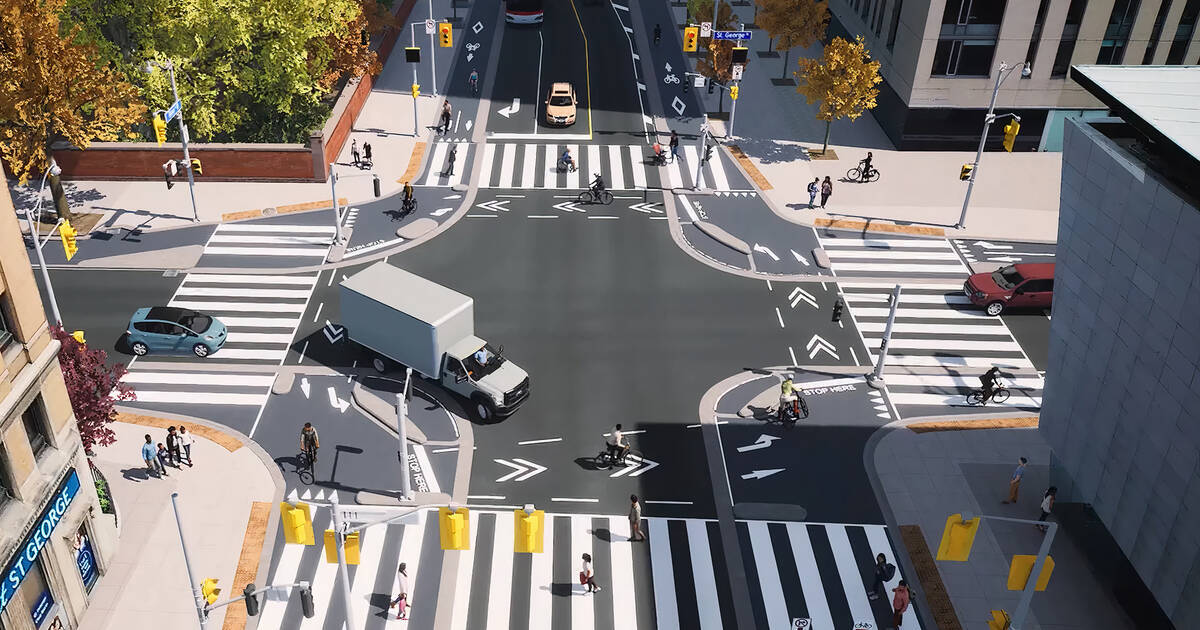Nice. It’d be better if the bike lanes were a different colour.
Agreed, I’d also like to see some bollards at the corners. With how I’ve seen drivers in this city behave, there’s going to be people driving right over those curbs.
Yeah just like the Dutch intersections. Which the article mentions they are based on.
In Canada street paint lasst ~2 years (it typically fades noticeably after the first winter) and during those 2 years it’s obfuscated by snow 10% of the time.
That’s because they’re driven on by cars. Pavement can last decades without potholes and only minimal repainting if it’s for pedestrians and bikes. That’s one of the reasons why car infrastructure is the most expensive transportation infrastructure possible. Cars are a huge drain on taxes.
I thinks the salt used for melting the ice, the high variations of temperature, the surface being wet non stop for weeks when the snow melts and the frequent snow plowing (which is a huge metal shovel that scraps the pavement) contributes a lot to the fading.
I fucking hate cars too and I agree with you they are completely inefficient. But paint on pavement in cities where the temperature is near 0°C a good part of the year is also inefficient.
I doubt the plowing is a big factor since we actually plow our bike lanes much less frequently than other cold countries like Finland and they paint their bike roads. Then again, you have a good point about paint being invisible because it gets covered in snow.
In Finland they use lamps above bike lanes to add colour and signage over the snow. I just think the gray asphalt makes it feel like the area is still for cars. That psychological effect is a huge part of good street design.
Pavement can last decades without potholes and only minimal repainting if it’s for pedestrians and bikes.
I would have agreed, but you should see the state of affairs that some of our bike paths are in, and it didn’t take decades for them to look like that. Our winters and the combination of salt + freeze/thaw cycles is what destroy asphalt.
Car’s don’t help, but they aren’t the main problem, or else you’d see highways crumbling after a few weeks with almost 400,000 cars and trucks driving on them daily (i.e. HWY 401).
There is a car-free island off of Toronto with pristine roads. Take a look at around the 2-minute mark of this Not Just Bikes video.
This is also why university campuses, which have tons of pedestrian pavement, aren’t full of potholes every spring. Same with outdoor malls, amusement parks, and on and on. The freeze thaw doesn’t help, but it isn’t the main problem.
Why not just install a roundabout?
A roundabout does not protect people riding bicycles. This intersection is designed to make them more visible to drivers.
deleted by creator
Removed by mod
Not if “protected” means “separated by a barrier”.
I’m interested in your design of a roundabout with a protected bike lane. Does it have over passes or underpasses?
Detect when a biker is approaching, let spikes spring up.
Wanna bet? 😂
Can you draw that? How does it work when a bicycle wants to go straight and a car wants to turn right? Either you would need underpasses/overpasses or accept that cars and bikes will constantly cross each other, which in practice means the bikes will be in danger.
deleted by creator
They put in protected bike lanes on big street near me. Bike lane-parking-traffic. So many ‘bike allies ‘ saying “it makes me more nervous to drive, I have to look for the cyclists now”.
In a large part of the US at least, it’s never going to be default behavior.
It makes me nervous as a cyclist, too. I think I’m safer taking the lane and navigating like a car than crossing a car’s path from a segregated right of way.
You could still put an obstruction in the middle to prevent t-bone collisions while keeping the bike and pedestrian spaces.
Because roundabouts prioritize motorists, their safety, and convenience. Clearly the goal here is to improve pedestrian and cyclist survival and convenience.
Do you any data supporting this ? I really wonder what would be best for cyclists.
Seems the opposite to me. I see in this picture what is essentially a roundabout but missing the central island, meaning people can drive straight through.
Roundabouts force motorists to slow down and can still provide a safe perimeter around the edge for pedestrians and bicyclists.
Have you crossed a roundabout by foot? The crosswalk is offset from the border of the road by like 5 meters, meaning it takes like twice as much to cross. The crosswalk is also not in the slowest part of the roundabout.
This intersection forces drivers to slow down by having floating islands that narrow the lanes and force tighter turning radii. Drivers going straight through interact with pedestrians and cyclists less than drivers who are turning because this is a signaled intersection.
Roundabouts need more space than a regular crossing and there are buildings on all four corners here.
That’s what mini roundabouts are for.
…at Bloor and St George? People walk here
Imagine if they had to drive in the UK lol
the corner of Bloor and St. George will be completely revamped in the Dutch style — that is, with greater prioritization of cyclists and pedestrians.
These style of intersections were all over the place when I lived in the Netherlands and they make cycling circulation much more fluid and safe. Hopefully they synchronize the lights properly using induction loops on the asphalt.
Also, can we get those in Montreal on the REV? Left turns are deadly for cyclists and drivers sometimes have trouble turning right during rush hour.
Pedestrians and bicyclists still have to wait 2 lights to turn left. Streets have been adapting to cars for around 80 years and it still not working
Hope it’s the first of many!
It’s good, but still needs raised barriers. You can see on the graphic a truck driving right over into the cycling lane.
“After worries about the first diverging diamond interchange”
Lol we’ve had these in Oklahoma for a fucking while… If we can handle it surely they can.
In the render it clearly shows no curb between cars and cyclist, so fuck all will change and they will keep parking and driving on cyclist lane. Not unless that is a shitty render and they are bringing actual curbs.










